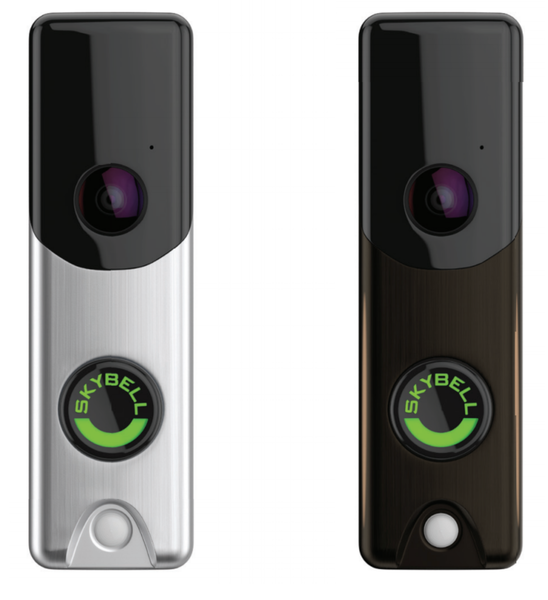New Alarm.com Slim Line II Doorbell Camera & ADC-VDB770 Doorbell Camera Accessories
Posted By Michael GorisWe have some exciting new products from Alarm.com now available on our site. The main highlight is the Alarm.com Slim Line II Doorbell Camera from SkyBell. We also have some great new accessories for the existing Alarm.com ADC-VB770 Doorbell Camera. These products are available now!

The SkyBell ADC-VDB105X (Satin Nickel) and SkyBell ADC-VDB106X (Bronze) refer to the new versions of the ADC-VB105 and ADC-VDB106. You may recall these as the "Slim Line" versions of the Alarm.com SkyBell Video Doorbells. The new models retain all of the existing features, while also offering some general improvements. While officially being titled as "SkyBell" devices, they are more commonly referred to as the Alarm.com Slim Line II Video Doorbell Cameras.
Some of the highlights for the Alarm.com Slim Line II Doorbell Cameras include their adjustable 720p recording resolution, their 1.3 MP full-color video camera, two-way voice functionality, WIFI connectivity, a 170° horizontal and 110° vertical field of view (FoV), IR night vision, an IPX4 weather-resistant rating, adjustable PIR sensitivity, real-time alerts, automation rules, an integrated battery heater for seamless operation in cold weather, doorbell-triggered and motion-triggered clips, and much more.
Since these are SkyBell devices, you can technically add one (1) of these devices to your Alarm.com account, even if you do not have true video monitoring service. If you do this, then you will be restricted to only one (1) SkyBell Doorbell Camera, along with 400 monthly clips and 400 total clips. This is a great option if you have an Alarm Grid Gold Plan, and you don't want to upgrade all the way to an Alarm Grid Platinum Plan for true video surveillance. More information can be found in this FAQ covering Alarm.com Clip Limits. Please note that if you want to use additional video devices or increase your clip limits, then you will need to upgrade to a full video monitoring plan. If you use one of these devices with a true video monitoring plan, such as an Alarm Grid Platinum Plan, then the doorbell will just count toward your regular Alarm.com Camera limits, as well as your Alarm.com Clip limits. Also keep in mind that since these are Alarm.com SkyBell models, they should not be used with any interactive platform outside of Alarm.com. They should also not be used with the native SkyBell App. Attempting to use one of these devices with the SkyBell App may make the camera completely incompatible with Alarm.com.
In addition to the Alarm.com Slim Line II Video Doorbell Cameras, we are also now offering several new doorbell camera accessories. These accessories are not for the new Alarm.com Slim Line II Doorbell Camera, but rather they are for the existing Alarm.com ADC-VDB770 Doorbell Camera. This is the "higher-end" doorbell camera that we began offering late last year. It represents the ultimate option for Alarm.com users who are looking for the very best doorbell camera available.
The new accessories for the ADC-VDB770 include:
- ADC-VDBA-COVER - Touchless Doorbell Cover that lets guests know to not touch the video doorbell. Used in conjunction with the Video Doorbell Mat.
- ADC-VDBA-MAT - Video Doorbell Mat that lets guests know to activate the camera by standing on the mat. Used in conjunction with the Touchless Doorbell Cover.
- ADC-VDBA-PSU-PD - Video Doorbell Wall Power Supply Kit that is used if there is no existing chime circuit, or if the chime circuit is incompatible. Can be used with or without a power module. Device is rated at 16 Volts DC, 1.25 Amps, or 20 Watts.
- ADC-VDBA-TC - Temperature Collar Accessory that allows the doorbell camera to be safely used in temperatures as low a -40°F. Can be used with or without the Wall Mounting Plate.
- ADC-VDBA-WP - Wall Mounting Plate that hides blemishes such as missing paint or screw holes. Goes in-between the wall and the doorbell camera. Dimensions are 5.43"L by 3.43"W.
If you have any questions about the Alarm.com Slim Line II Doorbell Camera or any of the new accessories for the ADC-VDB770, please email our support team at support@alarmgrid.com. That is also a good email to use if you are interested in starting new alarm monitoring service with Alarm Grid. We're here to answer your emails from 9am to 8pm ET M-F. We look forward to hearing from you!



 This time, Nortek, the parent company of 2GIG, declined to give a reason for the discontinuation of the 2GIG SP1. All we know is that it's gone. It was very sudden and unexpected. And since the other touchscreen keypad option for the GC3 and GC3e, the
This time, Nortek, the parent company of 2GIG, declined to give a reason for the discontinuation of the 2GIG SP1. All we know is that it's gone. It was very sudden and unexpected. And since the other touchscreen keypad option for the GC3 and GC3e, the 








 If your security system is using an AT&T 3G Communicator, then you must upgrade to LTE before January 31, 2022 to avoid a loss of
If your security system is using an AT&T 3G Communicator, then you must upgrade to LTE before January 31, 2022 to avoid a loss of